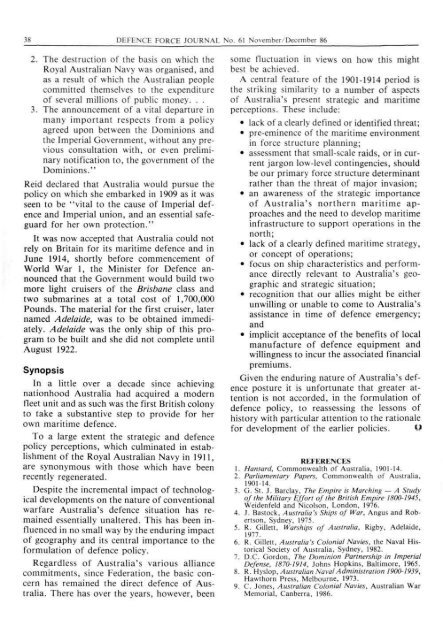ISSUE 61 : Nov/Dec - 1986 - Australian Defence Force Journal
ISSUE 61 : Nov/Dec - 1986 - Australian Defence Force Journal
ISSUE 61 : Nov/Dec - 1986 - Australian Defence Force Journal
You also want an ePaper? Increase the reach of your titles
YUMPU automatically turns print PDFs into web optimized ePapers that Google loves.
38 DEFENCE FORCE JOURNAL No. <strong>61</strong> <strong>Nov</strong>ember/<strong>Dec</strong>ember 86<br />
2. The destruction of the basis on which the<br />
Royal <strong>Australian</strong> Navy was organised, and<br />
as a result of which the <strong>Australian</strong> people<br />
committed themselves to the expenditure<br />
of several millions of public money. . .<br />
3. The announcement of a vital departure in<br />
many important respects from a policy<br />
agreed upon between the Dominions and<br />
the Imperial Government, without any previous<br />
consultation with, or even preliminary<br />
notification to, the government of the<br />
Dominions."<br />
Reid declared that Australia would pursue the<br />
policy on which she embarked in 1909 as it was<br />
seen to be "vital to the cause of Imperial defence<br />
and Imperial union, and an essential safeguard<br />
for her own protection."<br />
It was now accepted that Australia could not<br />
rely on Britain for its maritime defence and in<br />
June 1914, shortly before commencement of<br />
World War 1, the Minister for <strong>Defence</strong> announced<br />
that the Government would build two<br />
more light cruisers of the Brisbane class and<br />
two submarines at a total cost of 1,700,000<br />
Pounds. The material for the first cruiser, later<br />
named Adelaide, was to be obtained immediately.<br />
Adelaide was the only ship of this program<br />
to be built and she did not complete until<br />
August 1922.<br />
Synopsis<br />
In a little over a decade since achieving<br />
nationhood Australia had acquired a modern<br />
fleet unit and as such was the first British colony<br />
to take a substantive step to provide for her<br />
own maritime defence.<br />
To a large extent the strategic and defence<br />
policy perceptions, which culminated in establishment<br />
of the Royal <strong>Australian</strong> Navy in 1911,<br />
are synonymous with those which have been<br />
recently regenerated.<br />
Despite the incremental impact of technological<br />
developments on the nature of conventional<br />
warfare Australia's defence situation has remained<br />
essentially unaltered. This has been influenced<br />
in no small way by the enduring impact<br />
of geography and its central importance to the<br />
formulation of defence policy.<br />
Regardless of Australia's various alliance<br />
commitments, since Federation, the basic concern<br />
has remained the direct defence of Australia.<br />
There has over the years, however, been<br />
some fluctuation in views on how this might<br />
best be achieved.<br />
A central feature of the 1901-1914 period is<br />
the striking similarity to a number of aspects<br />
of Australia's present strategic and maritime<br />
perceptions. These include:<br />
• lack of a clearly defined or identified threat;<br />
• pre-eminence of the maritime environment<br />
in force structure planning;<br />
• assessment that small-scale raids, or in current<br />
jargon low-level contingencies, should<br />
be our primary force structure determinant<br />
rather than the threat of major invasion;<br />
• an awareness of the strategic importance<br />
of Australia's northern maritime approaches<br />
and the need to develop maritime<br />
infrastructure to support operations in the<br />
north;<br />
• lack of a clearly defined maritime strategy,<br />
or concept of operations;<br />
• focus on ship characteristics and performance<br />
directly relevant to Australia's geographic<br />
and strategic situation;<br />
• recognition that our allies might be either<br />
unwilling or unable to come to Australia's<br />
assistance in time of defence emergency;<br />
and<br />
• implicit acceptance of the benefits of local<br />
manufacture of defence equipment and<br />
willingness to incur the associated financial<br />
premiums.<br />
Given the enduring nature of Australia's defence<br />
posture it is unfortunate that greater attention<br />
is not accorded, in the formulation of<br />
defence policy, to reassessing the lessons of<br />
history with particular attention to the rationale<br />
for development of the earlier policies. U<br />
REFERENCES<br />
1. Hansard, Commonwealth of Australia, 1901-14.<br />
2. Parliamentary Papers, Commonwealth of Australia,<br />
1901-14.<br />
3. G. St. J. Barclay, The Empire is Marching — A Studv<br />
of the Military Effort of I he British Empire 1800-1945,<br />
Weidenfeld and Nicolson, London, 1976.<br />
4. J. Bastock, Australia's Ships of War, Angus and Robertson,<br />
Sydney, 1975.<br />
5. R. Gillett, Warships of Australia, Rigby, Adelaide,<br />
1977.<br />
6. R. Gillett, Australia's Colonial Navies, the Naval Historical<br />
Society of Australia, Sydney, 1982.<br />
7. D.C. Gordon, The Dominion Partnership in Imperial<br />
Defense, 1870-1914, Johns Hopkins, Baltimore, 1965.<br />
8. R. Hyslop, <strong>Australian</strong> Naval Administration 1900-1939,<br />
Hawthorn Press, Melbourne, 1973.<br />
9. C. Jones, <strong>Australian</strong> Colonial Navies, <strong>Australian</strong> War<br />
Memorial, Canberra, <strong>1986</strong>.

















